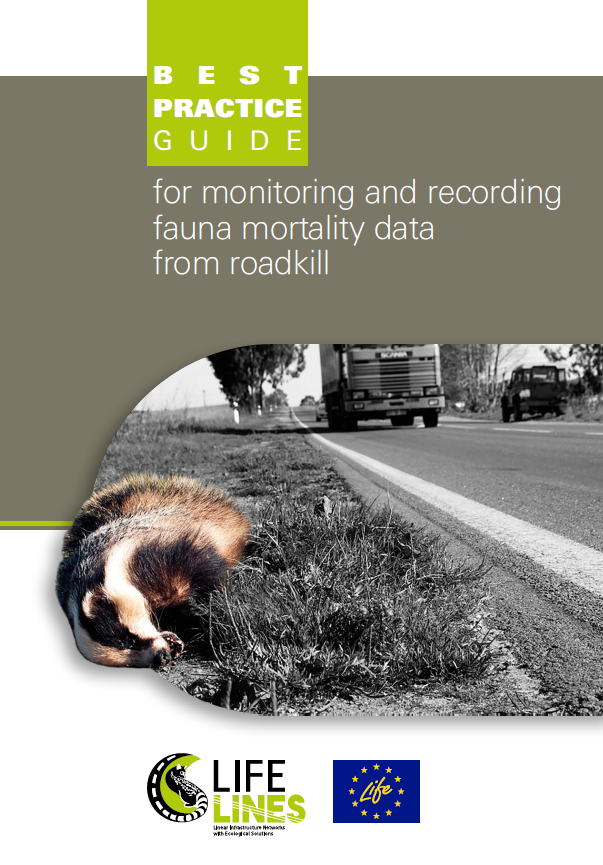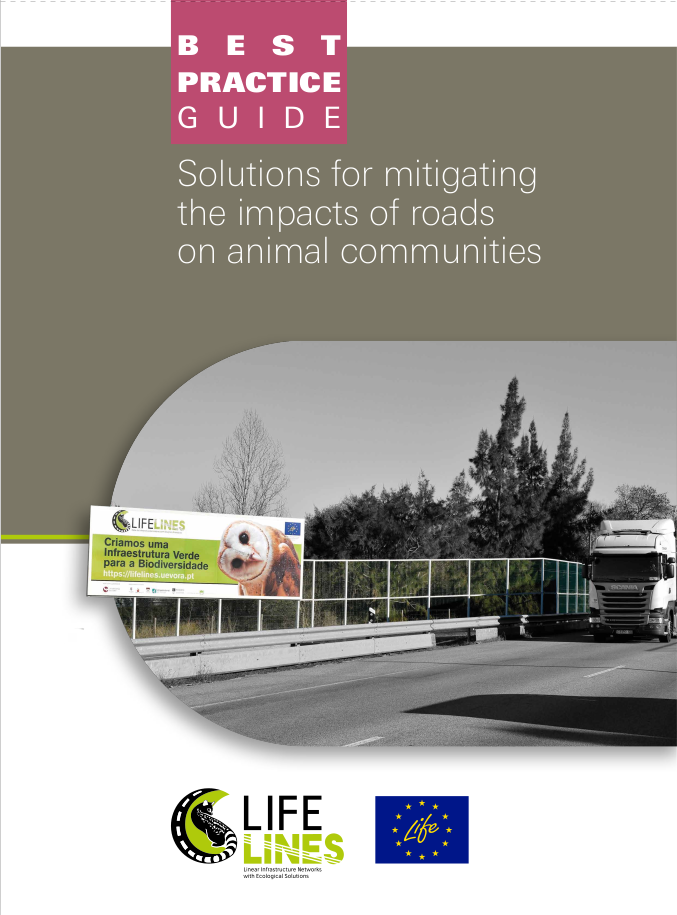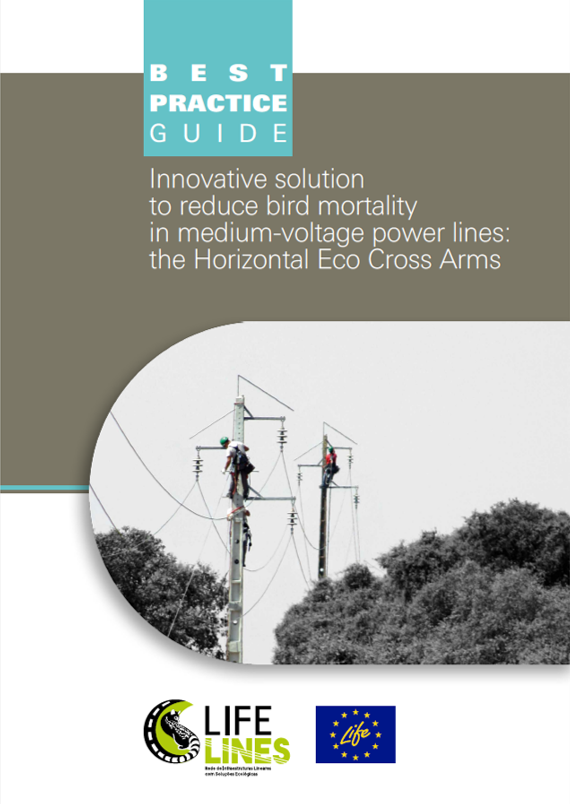Best Practice Guide for Monitoring and Recording Fauna Mortality Data from Roadkill
With the expanding network of transport infrastructures in Portugal over the last decades, roadkill became an imposing reality. In some parts of the country, this is the main non-natural cause of death for wildlife species. Therefore, it is crucial to obtain information on roadkill, namely the species and locations concerned, in order to determine the specific causes and to define appropriate mitigating measures.
This best practice guide gathers and presents the procedures for the collection and treatment of information from recorded fauna roadkill, based on the experience acquired in the framework of the LIFE LINES (LIFE14 NAT/PT/001081) project and others, such as MOVE project, conducted by the University of Évora. This guide presents basic or introductory aspects related with the implementation of a roadkill monitoring plan and is mainly directed to those involved in environmental monitoring, municipalities or local governances, and even concerned citizens. By offering the essential bases to adopt best practices for monitoring and recording roadkill, this guide is expected to help developing actions to mitigate fauna mortality and to increase road safety at local and national scales.
Download here the Best Practice Guide for Monitoring and Recording Fauna Mortality Data from Roadkill.

Best Practice Guide to Manage Vegetation and Promote Biodiversity in Linear Infrastructures
The expansion of linear infrastructures is one of the main causes of fragmentation and loss of natural habitats. Moreover, it is a powerful means of introduction and dissemination of invasive exotic flora. It is therefore crucial to manage the green areas associated with the linear infrastructures as areas of biodiversity conservation. For that purpose, solutions are needed that make the presence of the linear infrastructures compatible with nature conservation, especially in areas where the natural or semi natural landscapes are degraded and declining due to the intensification of land use through human activities.
The present guide is based on the experience acquired in the framework of the LIFE LINES project (LIFE14 NAT/PT/001081) and intends to compile and disseminate the recommendable procedures for the management of biodiversity, particularly of plant diversity, in the marginal zones of linear infrastructures, primarily focusing on the national roads, ancient railways now used for recreation (ecotrails) and power lines of very high voltage.
The guide includes technical information for those in charge of the management of roads, trails and power lines of very high voltage (concession holders, municipalities), for those who must evaluate environmental impacts (Agência Portuguesa do Ambiente, Instituto de Conservação da Natureza e Florestas), and for landscape and agroforestry technicians, as well as for the general public.
Download here the Best Practice Guide to Manage Vegetation and Promote Biodiversity in Linear Infrastructures.

Best Practice Guide of Solutions for Mitigating the Impacts of Roads on Animal Communities
With the expansion of the road network in Portugal over the last decades and increasing traffic, roadkill is ever more impacting road safety and species conservation. Habitat fragmentation and barrier effects, which hinder the connections between different populations and reduce their size, can threaten the viability of many populations and increase the risk of their extinction. For these reasons, it is crucial to implement solutions and procedures to promote connectivity among populations on each side of the roads and to reduce roadkill and road accidents.
This guide presents a set of interventions that were implemented and tested in the framework of the LIFE LINES project (LIFE14 NAT/PT/001081), coordinated by Universidade of Évora, in close partnership with authorities responsible for the management and maintenance of road infrastructures: IP – Infraestruturas de Portugal S.A., and the municipalities of Évora and Montemor-o-Novo. Due to the nature of the project and of its geographic framework, these actions are based on demonstrative and innovating solutions at the national level, primarily targeting animal communities, and whose effectiveness is evaluated in terms of success and cost of implementation and maintenance, aiming at their replication in future infrastructure contracts and other geographic contexts and species.
The present guide is meant to convey the implemented solutions, namely their characteristics, technical requirements, and cost-benefit evaluations, supporting the analysis of alternative solutions to prevent impacts on animal communities when planning new roads, requalifying existing road infrastructures, or mitigating localized roadkill. Concomitantly, this guide also aims at promoting road safety by reducing the risk of collisions with medium- to large-size animals. This information is directed to those who must evaluate environmental impacts (environmental agencies and nature conservation institutes), authorities in charge of road management (concession holders, municipalities), as well as project-designers, environmental consultants, road building and maintenance companies, and other agents concerned with the implementation of good environmental practices. This guide is applicable to the areas of land use planning, infrastructure’s project or management, and environmental sciences.
Download here the Best practice guide: Solutions for Mitigating the Impacts of Roads on Animal Communities.

Best Practice Guide. Innovative Solution to Reduce Bird Mortality in Medium-voltage Power Lines: the Horizontal Eco Cross Arms
Estimates indicate that tens of thousands of birds are killed in Portugal every year by collision with cables or electrocution on the utility poles of medium-voltage power lines. Some studies indicate that this effect led to the local decline of several threatened species, such as the Bonelli’s eagle or the little bustard. The severity of such impact justified the search of solutions to minimize the risk of bird mortality in power lines.
This guide aims to disclose an innovative solution to reduce bird mortality by collision and electrocution in medium-voltage power lines – the Horizontal Eco Cross Arms (ECO-HAL A25). This structure was implemented for the first time in the framework of the LIFE LINES project (LIFE14 NAT/PT/001081), coordinated by University of Évora, in close partnership with QUERCUS – A.N.C.N., responsible for the evaluation and monitoring of the impacts of power lines on avifauna, and with EDP Distribuição (now E-REDES -Distribuição de Eletricidade, SA), responsible for the management
and maintenance of the infrastructures of medium-voltage electric power distribution.
The primary objective of this guide is to present the characteristics and technical requirements of this structure, as well as the effectiveness and cost-benefit of its implementation in the structure of the electric poles, based on the analysis of the results obtained during the LIFE LINES project.
It is thus intended to contribute with an effective alternative for mitigation of bird mortality in medium-voltage power lines, by making it known to the various agencies dealing with electric power distribution, the public authorities concerned with nature conservation, and associations engaged in environmental protection.
Download here the Best Practice Guide. Innovative Solution to Reduce Mortality of Birds in Medium Voltage Power Lines - Pole Frame ECO- HAL A2S.

